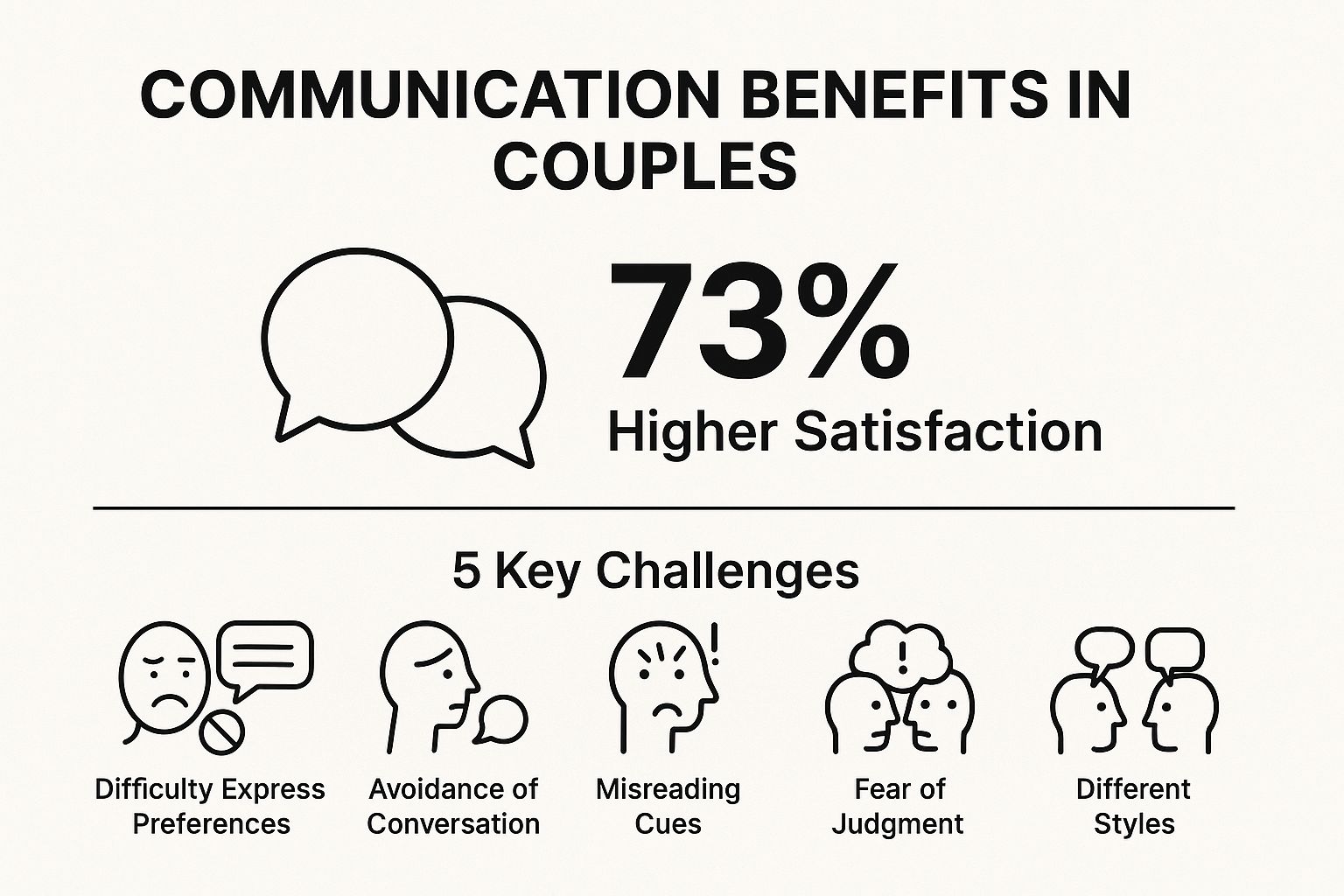Navigating Intimacy: Common Sex Challenges Couples Face
Intimacy is a vital part of any romantic relationship. This article addresses six common sex challenges for couples, offering solutions to build a stronger connection. Understanding these hurdles is the first step to overcoming them and improving your sex life. We’ll cover communication issues, mismatched libidos, performance anxiety, monotony in the bedroom, body image concerns, and the impact of life stress, providing actionable strategies to reignite the spark. If you and your partner are experiencing sex challenges, this listicle will help you identify the issues and offer solutions to deepen intimacy and pleasure.
1. Communication Mismatch
One of the most fundamental sex challenges couples face is the “Communication Mismatch.” This challenge describes the struggle partners experience when trying to openly discuss their sexual needs, desires, boundaries, and concerns. It creates a vicious cycle where assumptions replace actual knowledge about each partner’s wants, leading to unsatisfying sexual experiences and growing resentment within the relationship. This isn’t just about kinky sex or adventurous positions; it’s about the foundation of intimacy – understanding and being understood by your partner. For men especially, who are often socialized to avoid vulnerability, mastering this challenge can unlock a new level of connection and satisfaction.
Several key features characterize a communication mismatch. Difficulty expressing sexual preferences is a common symptom. Many people, regardless of gender, struggle to articulate what they truly desire in the bedroom, often due to fear of judgment or rejection. Avoidance of intimate conversations further exacerbates the issue. Couples may shy away from discussing their sexual needs, hoping the problems will resolve themselves, but this avoidance often leads to further misunderstandings. Misreading non-verbal cues can also contribute to the problem. One partner might interpret silence as disinterest, while the other might be simply processing their thoughts. Different communication styles between partners can also create a barrier. One partner might be direct and explicit, while the other prefers a more subtle and nuanced approach.
The consequences of an unaddressed communication mismatch can be severe, leading to long-term relationship damage, sexual frustration, and deep-seated resentment. Over time, the lack of communication can erode intimacy and create a widening gap between partners. However, overcoming this challenge can yield incredible benefits. Open communication fosters deep intimacy and trust, leading to better sexual satisfaction for both partners and strengthening overall relationship communication. When you and your partner can comfortably discuss your sexual needs and desires, you create a space for greater vulnerability and connection, enhancing all aspects of your relationship.
Examples of this challenge manifest in various ways. Partners who never discuss what they enjoy sexually are prime examples. They may engage in sexual activity, but it lacks the spark and fulfillment that comes from truly understanding each other’s desires. Couples who rely only on assumptions about their partner’s needs also fall into this category. Assumptions, however well-intentioned, are often inaccurate and can lead to disappointment. Relationships where one partner fakes satisfaction to avoid difficult conversations are another common scenario. This not only prevents the other partner from understanding their true needs but also creates a sense of inauthenticity and emotional distance.
So, when and why should you address this challenge? The answer is: as soon as possible. The longer you wait, the more ingrained these unhealthy patterns become. Don’t wait for resentment to build or for your sex life to become a source of stress. Proactive communication is key.
Here are some actionable tips to overcome the communication mismatch:
- Start conversations outside the bedroom: Initiate conversations about intimacy in a neutral, relaxed setting. This helps remove the pressure and allows for a more open dialogue.
- Use “I” statements: Express your own needs and desires using “I” statements, focusing on your feelings and experiences rather than criticizing your partner. For example, instead of saying “You never initiate sex,” try “I feel desired when you initiate intimacy.”
- Practice active listening: When your partner is speaking, actively listen without interrupting or getting defensive. Try to understand their perspective and validate their feelings.
- Consider using resources: Books, articles, or even relationship podcasts can be helpful conversation starters. They provide a framework for discussing sensitive topics and offer valuable insights. Learn more about Communication Mismatch
- Schedule regular check-ins: Set aside dedicated time to discuss your intimate life. This demonstrates commitment and creates a safe space for ongoing communication.
The infographic below visualizes key data on the benefits of improved communication in couples.

As the infographic highlights, couples who communicate effectively about their sexual needs report 73% higher satisfaction. This underscores the powerful impact that open communication can have on a couple’s intimate life. The infographic also identifies five key challenges to communication, reminding us that while these hurdles are common, they are not insurmountable. Addressing these challenges head-on is crucial to achieving a fulfilling and connected sexual relationship. Experts in relationship dynamics, such as Dr. John Gottman, Esther Perel, and Dr. Emily Nagoski, all emphasize the vital role of communication in building and maintaining healthy relationships, including a thriving sex life. By prioritizing open communication and actively working to overcome these challenges, couples can cultivate a deeper level of intimacy, trust, and sexual satisfaction.
2. Mismatched Libidos
One of the most common sex challenges for couples is the frustrating reality of mismatched libidos. This occurs when partners have significantly different levels of sexual desire, creating a breeding ground for tension and resentment. The higher-libido partner often feels rejected and unloved, constantly initiating sexual activity only to be met with disinterest. Conversely, the lower-libido partner can feel pressured and obligated, leading to resentment and a decrease in overall intimacy. This disparity isn’t about one partner being “right” and the other “wrong”; it’s often a complex issue stemming from a combination of biological, psychological, and circumstantial factors. Understanding these underlying causes is the first step towards bridging the desire gap and rediscovering a fulfilling sex life.

This challenge manifests in several ways. A significant difference in the desired frequency of sex is the most obvious sign. One partner might crave intimacy daily, while the other might only be interested weekly or even monthly. This leads to the higher-libido partner initiating sex much more often, creating a dynamic where one feels persistently pursued and the other perpetually pursued. Mismatched libidos also influence what each partner considers a “normal” sexual frequency, leading to disagreements and misunderstandings. Left unaddressed, these differences can create significant relationship stress, erode communication, and even contribute to infidelity or relationship breakdown. The emotional fallout can be substantial, often resulting in shame and self-doubt for both partners. The higher-libido partner might question their attractiveness and desirability, while the lower-libido partner might feel inadequate or broken.
However, mismatched libidos are not an insurmountable hurdle. Many couples successfully navigate this challenge through open communication, compromise, and a willingness to understand each other’s needs. For instance, a couple might find a middle ground by scheduling intimate time, reducing the pressure of spontaneous initiation and ensuring both partners feel considered. Another couple might discover that exploring non-sexual physical intimacy, like cuddling, kissing, and massage, helps maintain connection and fosters a sense of closeness without the pressure of intercourse. Successfully navigating this challenge can even lead to more creative and fulfilling intimacy, as partners learn to communicate their desires openly and experiment with new ways to connect.
For example, a man experiencing a decrease in libido due to work stress might communicate this to his partner, explaining that while his desire is lower, he still values their intimacy and wants to find ways to connect. His partner, understanding the situation, might suggest focusing on non-sexual intimacy for a while, such as cuddling and watching movies together, or exploring sensual massage. This approach allows them to maintain connection and affection without the pressure of sexual performance. Another example might involve a woman experiencing hormonal changes affecting her libido. Openly communicating this with her partner, and perhaps seeking professional guidance together, can empower them to find solutions like exploring different types of intimacy or adjusting their sexual routines to accommodate her changing needs.
Navigating mismatched libidos requires patience, understanding, and a commitment to avoiding blaming or shaming. It’s crucial to remember that fluctuations in libido are normal and can be influenced by a variety of factors, including stress, medication, hormonal changes, and even relationship dynamics. Addressing underlying health or stress factors is often crucial, as is practicing patience and avoiding taking differences personally.
When the gap in desire feels overwhelming or is causing significant distress, seeking professional help from a sex therapist or relationship counselor can be incredibly beneficial. Experts like Dr. Barry McCarthy, Michele Weiner-Davis, and Dr. Eli Coleman have popularized the importance of addressing libido differences and offer valuable insights into navigating this common challenge. Learn more about Mismatched Libidos to gain a deeper understanding of this complex issue. While mismatched libidos can be a significant hurdle for couples, it’s a challenge that can be overcome with open communication, empathy, and a willingness to prioritize intimacy in all its forms. This challenge deserves its place on the list of sex challenges for couples because it’s incredibly common and, if left unaddressed, can have a significant negative impact on the relationship. However, with the right approach, it can also be an opportunity for growth, deeper understanding, and a more fulfilling connection.
3. Performance Anxiety and Pressure
Performance anxiety and pressure is a significant sex challenge for couples, impacting intimacy and satisfaction for many. It’s the psychological hurdle where one or both partners experience anxiety about their sexual performance, leading to a self-perpetuating cycle. Worrying about performing well actually hinders sexual function and enjoyment, creating a frustrating and often disheartening experience. This isn’t a gender- or age-specific issue; it can affect anyone in a sexual relationship. Understanding this challenge is crucial for improving communication, fostering connection, and ultimately experiencing more fulfilling intimacy as a couple. This challenge definitely deserves a place on this list due to its prevalence and the profound impact it can have on a couple’s sex life.

This anxiety can manifest in various ways. Features include anxiety before or during sexual activity, overthinking sexual performance to the point of distraction, experiencing physical symptoms such as muscle tension or difficulty with arousal, and even avoiding sexual situations altogether. Instead of focusing on pleasure and connection, the individual becomes fixated on their perceived performance, creating a disconnect from the intimacy of the moment. This internal pressure can lead to several specific difficulties, such as erectile dysfunction stemming from anxiety rather than a physical issue, struggles reaching orgasm due to the pressure to perform, avoiding sex due to the fear of disappointing a partner, or experiencing premature ejaculation linked to performance stress.
While the potential consequences of performance anxiety are significant, including a severe impact on sexual satisfaction and frequency, decreased self-esteem, and reduced relationship confidence, there’s good news: it’s usually highly treatable. Addressing the underlying anxiety often leads to significant improvements in sexual function and enjoyment. Furthermore, working through this challenge together can foster better communication about sexual needs and desires within the relationship.
So how can couples navigate this common hurdle? One crucial step is shifting the focus from specific outcomes, such as achieving orgasm or maintaining an erection, to the pleasure and connection being shared. Practicing mindfulness and staying present during intimacy can also help alleviate anxiety and enhance the overall experience. Open and honest communication with your partner about anxieties is paramount. Creating a safe space to discuss these concerns can reduce the pressure and foster a sense of shared understanding and support. Taking the pressure off specific sexual acts or outcomes allows for more experimentation and exploration, which can reignite the spark and rediscover joy in intimacy.
Here are some actionable tips for managing performance anxiety:
- Prioritize Pleasure and Connection: Focus on the sensations, emotions, and connection with your partner rather than achieving a specific goal.
- Practice Mindfulness: Engage all your senses and stay present in the moment, letting go of distracting thoughts about performance.
- Communicate Openly: Talk to your partner about your anxieties and encourage them to share theirs. This fosters understanding and reduces pressure.
- Reduce Pressure on Specific Acts: Explore different forms of intimacy and don’t get fixated on one specific outcome.
- Relaxation Techniques: Practice deep breathing, meditation, or other relaxation techniques before intimate moments to calm your nerves.
If the anxiety is severe or significantly impacting your relationship, consider seeking professional therapy. A qualified therapist specializing in sex or relationship therapy can provide tailored guidance and support. Resources like Learn more about Performance Anxiety and Pressure can provide further insights and strategies. Pioneering figures in sex and relationship therapy, like Dr. Masters and Johnson, Dr. Helen Singer Kaplan, and Dr. David Schnarch, have highlighted the importance of addressing performance anxiety and its impact on intimate relationships. By understanding the dynamics of this challenge and implementing these practical tips, couples can overcome performance anxiety and cultivate a more fulfilling and connected sex life.
4. Monotony and Lost Spark
One of the most common sex challenges for couples, particularly those in long-term relationships, is the creeping in of monotony and the subsequent dimming of the initial spark. This challenge manifests as a gradual decline in sexual excitement and novelty, where intimacy becomes routine, predictable, or less frequent. While a comfortable rhythm can be a positive aspect of a long-term relationship, falling into a rut where sex feels like a chore rather than a shared pleasure can strain the connection between partners. This challenge involves reigniting passion while maintaining the deep comfort and emotional intimacy of an established relationship. It’s about rediscovering desire and excitement within the familiar landscape of love and commitment.

This challenge deserves a place on this list because it addresses a near-universal experience for couples. The initial intensity of a new relationship naturally evolves into a deeper, more comfortable connection. However, this comfort can sometimes lead to predictability in the bedroom. Recognizing and addressing this challenge is crucial for maintaining a healthy and fulfilling sex life. It’s about understanding that long-term desire requires effort, communication, and a willingness to break free from established routines.
The features of this challenge are often subtle at first. They may include predictable sexual routines and patterns, a decreased frequency of sexual activity, and less spontaneous physical affection. Couples experiencing this challenge might start feeling more like roommates than lovers, experiencing a sense of nostalgia for the passion they shared earlier in the relationship. For example, always having sex in the same position at the same time, or one partner consistently initiating intimacy while the other becomes passive, are classic signs of this challenge. Another example is when couples stop expressing non-sexual physical affection like cuddling, kissing, or holding hands, further contributing to the feeling of emotional and physical distance.
While the potential downsides are real, including the risk of seeking excitement outside the relationship or developing feelings of being taken for granted, the pros offer hope. This challenge can be revitalized with concerted effort and creativity. The deep emotional intimacy that long-term couples often share can serve as a strong foundation for reigniting the physical spark. Furthermore, these periods of decreased sexual intensity are often cyclical and may improve naturally over time. However, relying solely on time without active intervention is risky, as the issue can often worsen without conscious effort.
So, how do you combat monotony and reignite the lost spark? The key is to introduce novelty and intentionality back into your intimate life. This might involve exploring new locations for intimacy, changing the time of day you typically engage in sexual activity, or experimenting with new techniques and positions. Planning romantic dates and getaways, away from the distractions and pressures of daily routines, can also be highly effective. These experiences create opportunities for connection and reignite the feeling of being desired and pursued.
Trying new forms of foreplay or exploring different sexual activities together can also inject a sense of adventure and excitement. It’s essential to communicate openly and honestly with your partner about your desires and fantasies. Maintaining a degree of mystery and independence outside the relationship can also be beneficial. Having individual hobbies, interests, and social connections allows each partner to bring fresh energy and experiences back into the relationship.
Finally, expressing appreciation and desire for your partner regularly, both verbally and through actions, is paramount. Simple gestures like compliments, thoughtful gifts, or acts of service can go a long way in fostering a sense of being valued and desired. If you’re struggling to navigate this challenge on your own, consider couples’ workshops or retreats focused on intimacy. Experts like Esther Perel, author of “Mating in Captivity,” Dr. John Gottman, known for his relationship research, and Dr. Sue Johnson, a pioneer in Emotionally Focused Therapy, offer valuable insights and guidance for couples seeking to deepen their connection and reignite the spark. By understanding the dynamics of this challenge and taking proactive steps to address it, couples can cultivate a fulfilling and passionate sex life that endures through the years.
5. Body Image and Self-Consciousness
Body image and self-consciousness represent a significant sex challenge for couples, impacting intimacy and mutual pleasure. This challenge arises when negative feelings about one’s physical appearance interfere with sexual enjoyment. It’s a common hurdle, affecting both men and women, and can manifest in various ways, ultimately hindering a fulfilling sex life. This deserves a place on this list because it’s a frequently unspoken issue that can silently erode a couple’s connection and sexual satisfaction. Addressing it head-on can significantly improve intimacy and overall relationship health.
This challenge operates on a cycle of negative self-perception influencing behavior, which in turn reinforces those negative feelings. Someone worried about their stomach might avoid certain sexual positions, leading to less enjoyment and further reinforcing their insecurity. This can create a sense of distance and frustration for both partners. For men, societal pressures to appear strong and virile can exacerbate these feelings. They may worry about not measuring up to idealized images, leading to performance anxiety and decreased libido. Understanding that these anxieties are common is the first step toward overcoming them.
Features of this challenge often include:
- Self-consciousness about physical appearance during sex: This might involve constantly adjusting oneself, worrying about how one looks from certain angles, or avoiding eye contact.
- Avoidance of certain sexual positions or activities: This can stem from feeling self-conscious about specific body parts or fearing unfavorable comparisons.
- Distraction during intimate moments due to body concerns: Instead of being present and enjoying the experience, the individual is preoccupied with negative thoughts about their body.
- Difficulty being fully present and enjoying physical sensations: Self-criticism can override the ability to connect with physical pleasure.
- Impact of aging, weight changes, or medical conditions on self-image: Life’s transitions can significantly influence body image and introduce new insecurities. For example, men might struggle with body image changes related to aging, such as weight gain or decreased muscle mass.
Understanding the Pros and Cons:
While body image issues can feel overwhelming, it’s crucial to understand that they can be addressed and improved.
Pros:
- Can improve significantly with self-acceptance work: Focusing on self-love and appreciating one’s body for its functionality and sensuality can dramatically shift the experience of intimacy.
- Partner support and reassurance can be very effective: Open communication and genuine compliments from a loving partner can bolster self-esteem and reduce insecurities.
- Often lessens with age and maturity: As individuals gain life experience and prioritize deeper connections, superficial concerns about appearance often diminish.
Cons:
- Can severely limit sexual exploration and enjoyment: Fear of judgment can prevent couples from trying new things and fully expressing themselves sexually.
- May worsen over time without addressing underlying issues: Ignoring the problem allows negative self-talk to fester, potentially leading to decreased sexual desire and intimacy.
- Can create distance between partners: The lack of open communication and vulnerability can create a rift between partners, hindering emotional and physical connection.
Examples of this challenge in action:
- Avoiding sex with the lights on due to body shame.
- Refusing certain positions due to concerns about the appearance of one’s stomach or thighs.
- Post-pregnancy body image issues affecting a woman’s desire for intimacy.
- Aging-related changes, such as erectile dysfunction or weight gain, creating sexual self-consciousness in men.
Actionable Tips for Overcoming Body Image Challenges:
- Practice self-compassion: Treat yourself with the same kindness and understanding you would offer a friend. Focus on your positive qualities and what your body can do, rather than fixating on perceived flaws.
- Communicate with your partner: Share your insecurities and concerns with your partner. Open communication fosters understanding and allows them to offer support and reassurance. For men, this can feel particularly vulnerable, but it’s a vital step in building a stronger connection.
- Start intimacy in comfortable settings: If dim lighting or certain positions make you feel more at ease initially, embrace them. Gradually work towards expanding your comfort zone.
- Focus on physical sensations rather than appearance: Engage your senses during intimacy. Pay attention to the feel of your partner’s skin, the sounds of your breathing, and the emotional connection you share. This helps shift focus away from self-criticism.
- Consider professional help: If body image issues are significantly impacting your life and relationship, seeking therapy or counseling can provide valuable tools and strategies for self-acceptance.
- Engage in non-sexual physical activities that make you feel good about your body: This could include dancing, swimming, yoga, or any activity that allows you to appreciate your physical strength and capabilities. This positive reinforcement can translate into greater confidence in the bedroom.
By understanding the dynamics of body image and self-consciousness within the context of sex challenges for couples, and by implementing the tips outlined above, couples can cultivate a more positive, accepting, and fulfilling intimate life. Influential figures like Dr. Meredith Small, Sonya Renee Taylor, and Dr. Emily Nagoski offer further insights into body image, self-acceptance, and sexual well-being. Their work can provide additional resources for those seeking deeper understanding and practical strategies for navigating this common challenge.
6. Life Stress and Time Constraints
One of the most common sex challenges for couples in the modern world isn’t about desire or technique, but simply finding the time and energy for intimacy. This challenge, born from the pressures of daily life, can significantly impact a couple’s sex life and overall relationship satisfaction. Juggling work demands, parenting responsibilities, financial pressures, and the daily grind can leave couples feeling exhausted and disconnected, creating a vicious cycle where the lack of intimacy further exacerbates existing stress. This is a significant hurdle for many couples, making it a crucial inclusion in any discussion about sex challenges.
The hallmarks of this challenge are readily apparent in many relationships. Exhaustion becomes the norm, making the thought of physical intimacy feel like another chore rather than a pleasurable connection. Finding time for intimate moments feels impossible, with competing priorities constantly pushing intimacy down the to-do list. Even when couples do carve out time, mental preoccupation with daily stresses can make it difficult to be present and engaged. Different stress levels and coping mechanisms between partners can further complicate the issue, leading to misunderstandings and frustration.
For example, new parents are often utterly exhausted, leaving little energy for physical intimacy. Couples working opposite shifts may struggle to find any overlapping free time, effectively eliminating opportunities for connection. The stress of caring for an elderly parent or dealing with a major illness can consume a couple’s mental and emotional energy, leaving little space for intimacy. Similarly, financial stress can weigh heavily on both partners, making it difficult to relax and enjoy intimate moments.
While this challenge is undeniably difficult, it’s important to remember that it’s often temporary and related to specific life phases. The exhaustion of new parenthood eventually eases, work schedules can shift, and financial pressures may lessen. The good news is that with conscious effort, couples can overcome this hurdle and even strengthen their bond in the process.
Overcoming this challenge starts with communication. Openly discussing stress levels and supporting each other’s needs is paramount. It’s also vital to manage expectations. During particularly high-stress periods, lowering expectations for the frequency and intensity of intimacy, while still maintaining connection through other means, can be beneficial. Prioritizing intimacy, even in small ways, is key. Scheduling intimate time, just like any other important appointment, can ensure it doesn’t get lost in the shuffle.
Focusing on brief but meaningful physical connections, like cuddling, holding hands, or a quick kiss, can maintain a sense of intimacy even when time is limited. Practicing stress-reduction techniques together, such as meditation or deep breathing exercises, can create a shared sense of calm and connection. Stress and time constraints can impact a couple’s sex life. Even having the energy to think about what’s needed to keep the spark alive can be a challenge. This is often compounded if you’re relying on special date nights or using specific products. Make sure you’re approaching intimacy with all of your needs in mind by having the right equipment . Finally, considering getting help with stressors, such as hiring a babysitter, asking family for support, or seeking professional help for financial or emotional issues, can free up valuable time and energy.
While the pros of overcoming this challenge include a stronger relationship and a renewed sense of intimacy, the cons of neglecting it are significant. Long-term patterns of neglecting intimacy can lead to couples growing apart emotionally and physically. Without conscious intervention, the problem often worsens, creating deeper rifts in the relationship. The work of researchers like Dr. John Gottman and Dr. Julie Gottman in the field of relationship research under stress, and Brené Brown’s research on stress and vulnerability, highlights the impact of stress on intimate relationships and offers valuable insights into navigating these challenges.
Successfully navigating life stress and time constraints as a couple requires understanding, communication, and a commitment to prioritizing intimacy. By implementing these tips and recognizing the importance of connection even amidst the chaos of daily life, couples can not only overcome this common sex challenge but also build a stronger, more resilient relationship.
6 Key Sex Challenges Compared
| Challenge | Implementation Complexity  |
Resource Requirements  |
Expected Outcomes  |
Ideal Use Cases  |
Key Advantages  |
|---|---|---|---|---|---|
| Communication Mismatch | Moderate – requires ongoing dialogue | Low to Moderate – time and effort | Higher intimacy and trust; 73% higher satisfaction rates | Couples struggling to express needs and boundaries | Builds deep intimacy and strengthens communication |
| Mismatched Libidos | Moderate to High – needs compromise | Moderate – communication, possible therapy | 65% success in workable solutions; improved connection | Partners with differing sexual desire levels | Promotes creative compromise and empathy |
| Performance Anxiety and Pressure | Moderate – requires behavioral change | Moderate – therapy and mindfulness | 70-80% success in anxiety reduction; improved sexual function | Individuals/couples facing performance-related anxiety | Highly treatable; enhances overall sexual confidence |
| Monotony and Lost Spark | Moderate to High – needs sustained effort | Low to Moderate – creativity, time | 85% higher long-term satisfaction when addressed | Long-term couples experiencing reduced excitement | Revitalizes passion while maintaining comfort |
| Body Image and Self-Consciousness | Moderate – requires self-work and support | Low to Moderate – self-help + support | Significant improvement in sexual enjoyment with interventions | Individuals with negative body image impacting intimacy | Encourages self-acceptance and partner reassurance |
| Life Stress and Time Constraints | Moderate – involves lifestyle adjustments | Moderate – time management, stress reduction | Improved intimacy; better stress coping; 78% couples cite stress impact | Couples with high external stress/limited time | Strengthens relationship through shared coping |
Rekindling the Flame: Moving Forward with Intimacy
Navigating sex challenges for couples is a common experience, and understanding the root causes, like communication mismatch, mismatched libidos, performance anxiety, monotony, body image concerns, and life stress, is the first step towards rekindling the flame. We’ve explored these common hurdles and offered practical strategies to address each, empowering you to create a more fulfilling and intimate connection with your partner. Remember, open communication, active listening, and mutual respect are the cornerstones of a healthy and satisfying sex life. Prioritizing intimacy, even amidst busy schedules, demonstrates commitment to your relationship and fosters deeper emotional connection.
Mastering these concepts is crucial because a thriving intimate life strengthens your bond, boosts emotional well-being, and enhances overall relationship satisfaction. By actively working through these sex challenges for couples, you’re investing in a stronger, more connected, and ultimately, happier partnership.
Overcoming these challenges isn’t always easy, and seeking professional guidance from a therapist or counselor can provide valuable support. They can offer personalized strategies and address any underlying issues impacting your intimacy. Remember, investing in your intimate connection is an investment in your relationship’s future.
Want to deepen your understanding of your partner’s pleasure and enhance your intimacy even further? Explore G-Spot 101 (G-Spot 101 ), a valuable resource to help couples explore female anatomy and unlock new levels of pleasure, addressing some of the common challenges discussed above. It’s a powerful tool to add to your intimacy toolkit.
The post Overcome Sex Challenges for Couples | Expert Tips & Strategies appeared first on G Spot 101 .
Intimate Tickles found this article quite interested, and we thought you might to. We give all the credit for this article to gspot. Click Here To Read This Article From It's Original Source



